Evidence that separate neural circuits in the nucleus accumbens encode cocaine versus "natural" (water and food) reward
- PMID: 10818162
- PMCID: PMC6772653
- DOI: 10.1523/JNEUROSCI.20-11-04255.2000
Evidence that separate neural circuits in the nucleus accumbens encode cocaine versus "natural" (water and food) reward
Abstract
Electrophysiological recording procedures were used to examine nucleus accumbens (Acb) cell firing in rats trained to press a lever on a multiple schedule [ fixed ratio (FR)1, FR1] for either two "natural" reinforcers (food and water), or a natural reinforcer and intravenous self-administration of cocaine. Of 180 cells recorded during water and food reinforcement (n = 13 rats), 77 neurons were classified as phasically active, exhibiting one of three well-defined types of patterned discharges relative to the reinforced-response (Carelli and Deadwyler, 1994). Of the 77 phasic cells, the majority (68%) showed similar types of patterned discharges across the two natural reinforcer conditions. In contrast, of 127 neurons recorded during water and cocaine reinforcement (n = 8 rats), only 5 of 60 phasically active cells (8%) exhibited similar types of patterned discharges relative to water- and cocaine-reinforced responding. The remaining 55 phasic cells (92%) displayed patterned discharges relative to the cocaine-reinforced response (n = 26 cells), or relative to the water-reinforced response (n = 29 cells), but not both. For some rats (n = 3), food was substituted for water in the task. Again, the majority of phasic neurons (13 of 14 cells, 93%) exhibited nonoverlapping firing patterns across the drug and natural reinforcer conditions. These findings indicate that in the well-trained animal, cocaine activates a neural circuit in the Acb that is largely separate from the circuit that processes information about food and water reward.
Figures




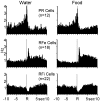

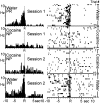
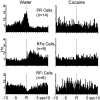

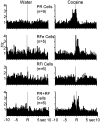

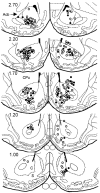
References
-
- Alexander GE, Crutcher MD. Functional architecture of basal ganglia circuits: neural substrates of parallel processing. Trends Neurosci. 1990;13:266–271. - PubMed
-
- Alexander GE, DeLong MR, Strick PL. Parallel organization of functionally segregated circuits linking basal ganglia and cortex. Annu Rev Neurosci. 1986;9:357–381. - PubMed
-
- Apicella P, Ljungberg T, Scarnati E, Schultz W. Responses to reward in monkey dorsal and ventral striatum. Exp Brain Res. 1991;85:491–500. - PubMed
-
- Bardo MT. Neuropharmacological mechanisms of drug reward: beyond dopamine in the nucleus accumbens. Crit Rev Neurobiol. 1998;12:37–67. - PubMed
-
- Bassareo V, Di Chiara G. Differential responsiveness of dopamine transmission to food-stimuli in nucleus accumbens shell/core compartments. Neuroscience. 1999;89:637–641. - PubMed
Publication types
MeSH terms
Substances
Grants and funding
LinkOut - more resources
Full Text Sources
Other Literature Sources
